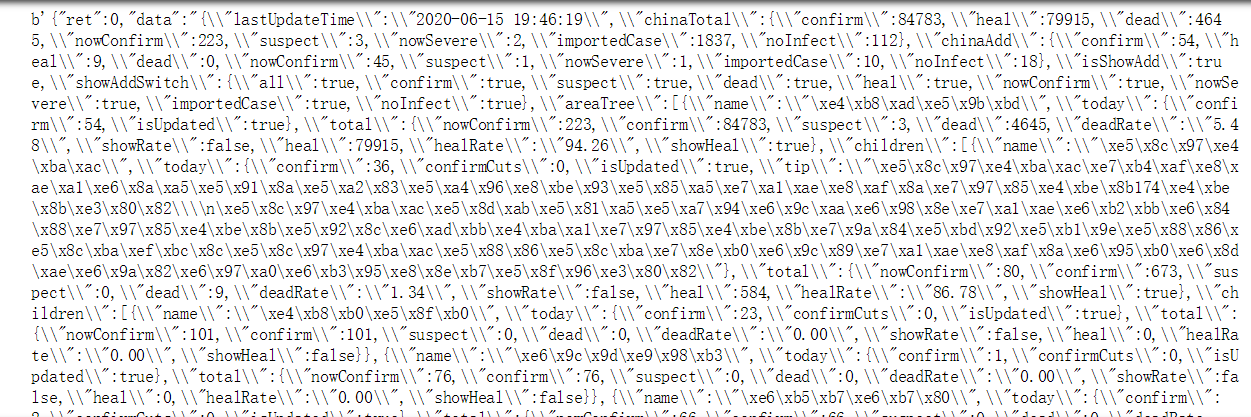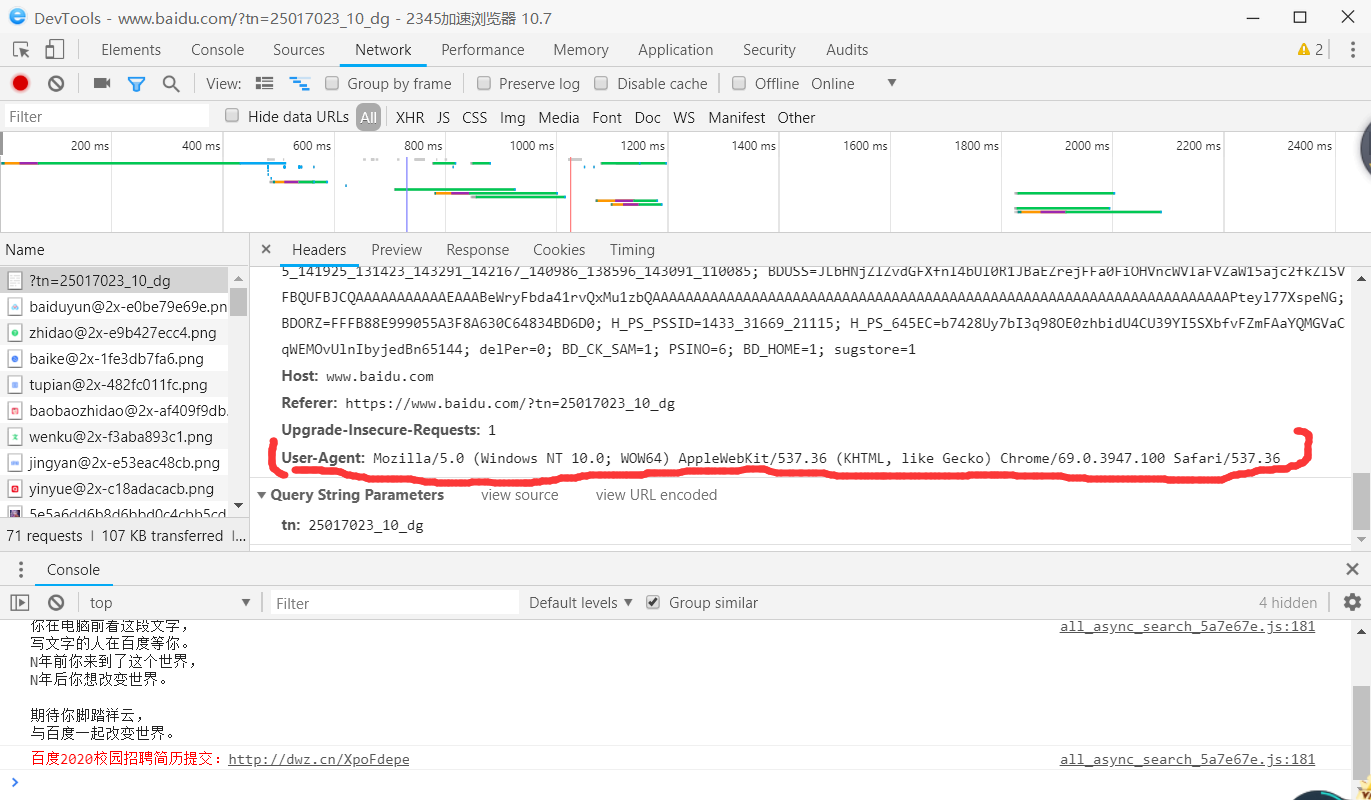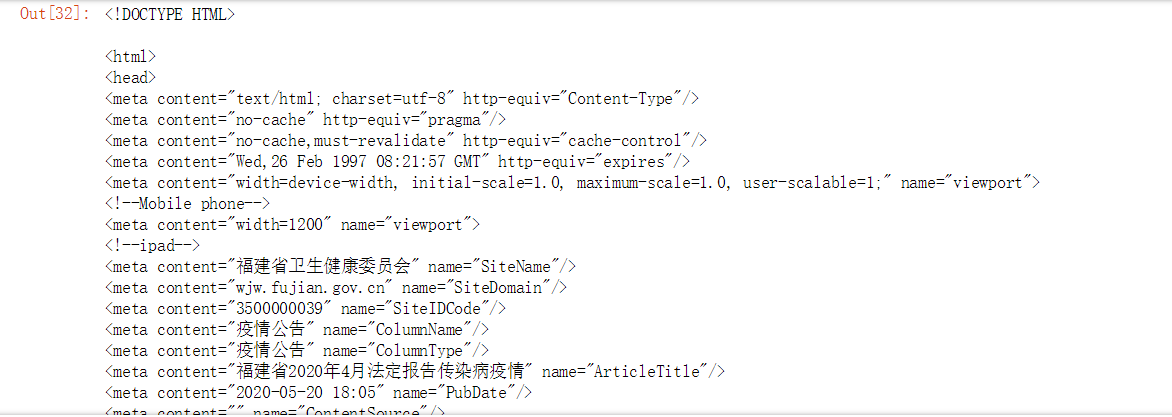1、技术概述
- 爬虫,就是给网站发起请求,并从响应中提取需要的数据的自动化程序,一般有三个步骤:
(1)发起请求,获取响应
(2)解析内容
(3)保存数据 - 当初学习该技术是因为要做疫情网页,需要准确的疫情数据。
- 技术难点:或许需要去了解一下爬虫的字典和列表。
2、技术详述
- 仅到爬取数据并存储数据到数据库阶段,需要安装Python 3.6,MySQL,Jupyte notebook(Python IDE)(安装方法自己百度),启动jupyter notebook(基础使用教程请自己百度,很简单的)
- 发起请求,获取响应
- 不少网站有反扒措施,为了避免这个,我们可以冒充各种搜索引擎去爬取,比如百度,谷歌。
输入百度网址www.baidu.com,按下F12进入开发者页面(不同浏览器间可能不同),如图找到百度的User-Agent数据,这个数据用来标识访问者身份,这个就是咱们冒充百度的关键
- 有两种发起请求的方式,其一是用urllib,主要用的是其中的request.urlopen()方法
from urllib import request
url = "https://view.inews.qq.com/g2/getOnsInfo?name=disease_h5" #这是你想爬取数据的地址
header = {
"User-Agent": "Mozilla/5.0 (Windows NT 10.0; WOW64) AppleWebKit/537.36 (KHTML, like Gecko) Chrome/69.0.3947.100 Safari/537.36"
} #就是上一点中得到的那个User-Agent,这一步我们冒充成百度
req = request.Request(url,headers = header)
res = request.urlopen(req) #访问url并获取响应
html = res.read()#获取的是字节形式的内容
html.decode("utf-8")#解码,如果是乱码的话
print(html)
运行结果:

- 第二种是使用requests发送请求
这里要注意:如果是以前没有装过requests库的话,要在命令行安装一下:pip install requests,主要用到的命令是requests.get()
import requests
url = "https://view.inews.qq.com/g2/getOnsInfo?name=disease_h5" #这是你想爬取数据的地址
header = {
"User-Agent": "Mozilla/5.0 (Windows NT 10.0; WOW64) AppleWebKit/537.36 (KHTML, like Gecko) Chrome/69.0.3947.100 Safari/537.36"
}
r1 = requests.get(url,headers = header)#发起请求
r1.encoding = "UTF-8"
html = r1.text
print(html)
可以看出代码和用urllib的没太大区别,运行后结果一样的,就不贴图了
3. 解析内容
- 解析内容也有两种方式,一种是beautifulsoup4,beautifulsoup4将复杂的HTML文档转化成一个树状结构,每个节点都是Python的对象,find(),select(),find_all()函数获取标签。安装命令:pip install beautifulsoup4
import requests
from bs4 import BeautifulSoup #别忘了导入库啊
url = "http://wjw.fujian.gov.cn/xxgk/gsgg/yqgg/202005/t20200520_5270636.htm" #这是你想爬取数据的地址,例子是福建卫健委4月法定报告传染病疫情报告,不再是数据整理好的接口了
header = {
"User-Agent": "Mozilla/5.0 (Windows NT 10.0; WOW64) AppleWebKit/537.36 (KHTML, like Gecko) Chrome/69.0.3947.100 Safari/537.36"
}
r1 = requests.get(url,headers = header)#发起请求
r1.encoding = "UTF-8"
#r1.text
html = r1.text
#BeautifulSoup(html)#整理了数据,想要的数据可以整理后一个个去找,更方便的是去你想爬取数据的网站打开F12开发者工具,左上角有个选择元素,可以直接在网页上定位标签
soup = BeautifulSoup(html)
#soup.find("font").text #可以拿到font标签里的文本,如果是.attrs则可以拿到标签属性,若只有soup.find("font"),则是整个标签+内容,怎么得到你要找的数据需要好好找找资料,如果用find()得到的是第一个符合的标签,find_all得到的是所有符合条件的标签
res=soup.find("font")
print(res)
print(res.text)
print(res.attrs)
先看看未解析内容前的效果(运行到r1.text命令):
解析后效果(运行到BeautifulSoup(html)命令):
soup.find("font")soup.find("font").textsoup.find("font").attrs三个运行结果:
- 另一种是re,要对正则表达式有一定理解
当初是从腾讯接口爬取疫情数据,数据持久化在本地数据库,完整代码(仅显示爬虫爬取数据部分,不包括数据库):
import requests
import json
import pymysql
import time
import traceback
def getdata():#从腾讯接口爬取数据,并存到字典及列表中
url = "https://view.inews.qq.com/g2/getOnsInfo?name=disease_h5"
header = {
"User-Agent": "Mozilla/5.0 (Windows NT 10.0; WOW64) AppleWebKit/537.36 (KHTML, like Gecko) Chrome/69.0.3947.100 Safari/537.36"
}
r1 = requests.get(url,headers = header)
res1 = json.loads(r1.text)
data_all = json.loads(res1["data"])
url2 = "https://view.inews.qq.com/g2/getOnsInfo?name=disease_other"
r2 = requests.get(url2,headers = header)
res2 = json.loads(r2.text)
odata_all = json.loads(res2["data"])
country_history = {}#历史数据,全国
for i in odata_all["chinaDayList"]:
ds ="2020."+ i["date"]
tup =time.strptime(ds,"%Y.%m.%d")
ds =time.strftime("%Y-%m-%d",tup)
confirm =i["confirm"]
heal=i["heal"]
dead=i["dead"]
country_history[ds] ={"confirm":confirm, "heal":heal, "dead":dead}
for i in odata_all["chinaDayAddList"]:
ds ="2020."+ i["date"]
tup =time.strptime(ds,"%Y.%m.%d")
ds =time.strftime("%Y-%m-%d",tup)
confirm =i["confirm"]
country_history[ds].update({"confirm_add":confirm})
details =[]#各省数据
update_time=data_all["lastUpdateTime"]
data_province=data_all["areaTree"][0]["children"]
for pro_infos in data_province:
province=pro_infos["name"]
confirm=pro_infos["total"]["confirm"]
confirm_add=pro_infos["today"]["confirm"]
heal=pro_infos["total"]["heal"]
dead=pro_infos["total"]["dead"]
details.append([update_time,province,confirm,confirm_add,heal,dead])
country_now =[]#全国如今数据
update_time =data_all["lastUpdateTime"]
nowConfirm =data_all["chinaTotal"]["nowConfirm"]
suspect =data_all["chinaTotal"]["suspect"]
nowSevere =data_all["chinaTotal"]["nowSevere"]
confirm =data_all["chinaTotal"]["confirm"]
heal =data_all["chinaTotal"]["heal"]
dead =data_all["chinaTotal"]["dead"]
nowConfirm_add =data_all["chinaAdd"]["nowConfirm"]
suspect_add =data_all["chinaAdd"]["suspect"]
nowSevere_add =data_all["chinaAdd"]["nowSevere"]
confirm_add =data_all["chinaAdd"]["confirm"]
heal_add =data_all["chinaAdd"]["heal"]
dead_add =data_all["chinaAdd"]["dead"]
country_now.append([update_time,nowConfirm,suspect,nowSevere,confirm,heal,dead,nowConfirm_add,suspect_add,nowSevere_add,confirm_add,heal_add,dead_add])
province_history = []#历史数据,各省
ds=time.strftime("%Y-%m-%d")
data_province=data_all["areaTree"][0]["children"]
for pro_infos in data_province:
province=pro_infos["name"]
confirm=pro_infos["total"]["confirm"]
confirm_add=pro_infos["today"]["confirm"]
heal=pro_infos["total"]["heal"]
dead=pro_infos["total"]["dead"]
province_history.append([ds,province,confirm,confirm_add,heal,dead])
return country_history,details,country_now,province_history
- 保存数据
上一步已经得到爬取数据,并把它们暂时放在列表和字典里,那么爬取的数据要怎么存储进本地数据库呢?
下面是其中一个更新details表的例子,其它大同小异。
def get_conn():#把常用的函数封装,打开关闭数据库链接
conn=pymysql.connect(host="localhost",
user="root",
password="123456",
db="covtest",
charset="utf8")
cursor=conn.cursor()
return conn,cursor
def close_conn(conn,cursor):
if cursor:
cursor.close()
if conn:
conn.close()
def update_details():#更新details表,因为用了insert命令,所以取出时必须判断最新时间为最新数据
cursor=None
conn=None
try:
li=getdata()[1]
conn,cursor=get_conn()
sql ="insert into details(update_time,province,confirm,confirm_add,heal,dead) values(%s,%s,%s,%s,%s,%s)"
sql_query='select %s=(select update_time from details order by id desc limit 1)'
cursor.execute(sql_query,li[0][0])
if not cursor.fetchone()[0]:
print(f"{time.asctime()}开始更新最新数据")
for item in li:
cursor.execute(sql,item)
conn.commit()
print(f"{time.asctime()}更新最新数据完毕")
else:
print(f"{time.asctime()}已是最新数据!")
except:
traceback.print_exc()
finally:
close_conn(conn,cursor)
3、技术使用中遇到的问题和解决过程
1.notebook下载超时

2.如图

4、进行总结。
步骤:
- 1)发起请求,获取响应(urllib、requests)
- 2)解析内容(re、beautifulsoup4)
- 3)保存数据(保存在本地库或云数据库)



